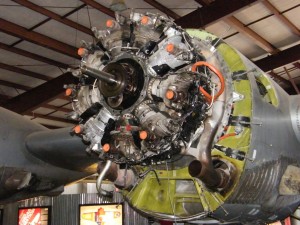By J Carpenter
The systematic destruction of decommissioned military aircraft occurred at an alarming rate in the years following World War II. Little was being done to preserve these artfully engineered planes known as warbirds. Then, a small group of aviation enthusiasts in south Texas went into action, determined to save, in flying condition, a representative collection of U.S. combat aircraft from WWII.
They began by buying a Curtiss P-40 Warhawk in 1951. Next, the group purchased a North American P-51 Mustang and two Grumman F8F Bearcats. More acquisitions followed, and in 1961, the Confederate Air Force was chartered as a nonprofit Texas corporation. The organization completed its first museum building in 1965 at old Rebel Field located in Mercedes, Texas. The CAF created a new Rebel Field at Harlingen, when it moved there in 1968, occupying three large buildings. Its air fleet continued to grow, including medium and heavy bombers such as the Boeing B-29 Superfortress, the Boeing B-17 Flying Fortress, the Consolidated B-24 Liberator and the Mitchell B-25 (made famous by the Doolittle raid on Japan in early 1942).
In 1991, the CAF began a new era by moving into facilities in Midland, Texas. The organization changed its name to the Commemorative Air Force in 2001, and today boasts more than 9,000 members operating a fleet of more than160 aircraft in 23 states. There are also squadrons in France, New Zealand and Switzerland, plus individual members in 27 countries, all operating under the name “Ghost Squadron.”
The B-29 Fifi restoration
Boeing Aircraft built more than 4,000 B-29 Superfortress bombers in the 1940s. Today, only one B-29 remains airworthy. The story of its survival began in 1971, when a pilot reported sighting what appeared to be several B-29s on the California desert near China Lake. Subsequent investigation revealed that the weather-beaten planes had been used as gunnery targets. The CAF negotiated with the Air Force and eventually became the owner of B-29 SN44-62070. Records indicate that the Boeing plant in Renton, Wash., manufactured Fifi in 1945.
A CAF maintenance team arrived at China Lake to restore all systems, run the engines, test the propellers and landing gear, and install new window bubbles. With the help of CAF volunteers, the team accomplished this task in only nine weeks. By Aug. 3, 1971, SN44-62070 was ready to fly again. The crew took on enough fuel to fly nonstop 1,250 miles to CAF headquarters in Harlingen. The B-29 joined the other WWII fighters and bombers after her christening as Fifi. The long and expensive project involved more than three years of fundraising.
Fifi B-29 features
Col. Lyn Fite is the CAF squadron leader for the B-24 and B-29 projects. Recently, he conducted a tour of two aircraft located at the CAF’s restoration hangar located at Midland International Airport (MAF).
The B-29 is 99 feet long, 29 feet, 7 inches high and has a wingspan of 142 feet, 3 inches. Fite explained that the combat version had a computerized central fire control system. Twin 50-caliber M2/machine guns were mounted on the lower turret, and there were four more on the top turret. There were two additional machine guns on top of the fuselage in the back, two below on the back and twin machine guns for the tail gunner. The position for the central fire controller was toward the rear of the fuselage.
“A gunner would sit in what is called a “barber’s chair” and stick his head up into a Plexiglas bubble window,” said Fite. “He could then swivel 360 degrees around for a view in any direction.”
The gunner controlled the four guns on top forward and the two top guns in the rear, either independently or in unison. The only designated gun position was the tail gunner. All gun sights were electronically controlled. As the gunners moved their sights up and down, the guns followed by remote electric motor controls.
“Once the gunner had the enemy aircraft sighted, the computer would automatically calculate the wind currents and the ‘lead’ required to hit the enemy aircraft. Consequently, they didn’t have to fire glowing tracer bullets that allow the gunner to sight the path of the bullets.”
Fite explained that in the B-24s and B-17s, every fifth round of a machine gun belt contained a tracer bullet that glowed brightly to help the gunner aim at his target.
“That wasn’t needed for the B-29,” he said. Fite added that in the Korean conflict, this firing system wasn’t as accurate because the enemy aircraft had evolved into jets that were too fast for the system.
The B-29 could carry 20,000 pounds of standard bombs or one atomic bomb. Superfortresses delivered two atomic bombs (nicknamed “Little Boy” and “Fat Man”) to Hiroshima and Nagasaki, Japan, speeding the end of WWII.
The B-29 has pressurized compartments for the crew. This allowed flight without oxygen to altitudes of 40,000 feet at speeds approaching 350 miles per hour. Heated compartments allowed the crews to fly without having to wear heavy insulated clothes. A separate pressurized compartment housed the rear gunner. A duct system connects the rear gunner’s station to the front pressurized compartments.
Except for hydraulic braking, all B-29 systems are electric. An auxiliary power unit provides power to these systems and is the first thing started on the aircraft. The APU is a two-cylinder air-cooled engine that burns avgas, which in turn runs a 200-amp generator.
“We put that system online and then go ahead and start all the engines,” Fite explained. “We leave the APU online as back-up power to all electrical systems until we get to cruise altitude.”
In combat scenarios, the APU operator was the tail gunner. He was isolated from the rest of the aircraft.
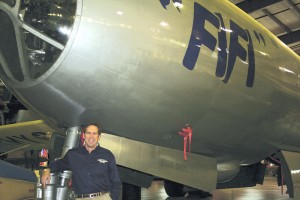
CAF president and CEO Steve Brown poses in front of the nose gear of Fifi in the CAF restoration hangar.
“He’s the loneliest guy in the airplane,” said Fite. “The entire plane’s pressure system had to be depressurized to get him out.”
Fite said that when they fly Fifi on tour, they don’t pressurize or go above 10,000 feet.
“We keep the pressure system installed as a static display,” he said.
The distance from a B-29 cockpit back to its engines doesn’t allow pilots an adequate view of the plane’s rear section. The crew’s “lead scanner” supervises that area and acts as the boss-man in the rear of the aircraft. He and other scanners monitor the flap, aileron, landing gear systems and engines through the bubble windows located on the sides of the fuselage.
A training aircraft based at Randolph Air Force Base before it was decommissioned, Fifi is fitted with the once-secret Norton bomb site.
“It was donated to the CAF by Tennessee Ernie Ford, a former member of our squadron,” said Fite.
Flying the B-29
A 10-man crew was usually on the B-29 including, two pilots, a bombardier, navigator, flight engineer, communications officer and four gunners. The flight engineer sits behind the pilots and is in charge of starting the engines. He also monitors and maintains the engines during flight. A crewmember stands outside the aircraft with a communication ‘long line’ connected to the cockpit. He checks for fires or other problems during engine start up. After warming up the engines, the engineer turns the controls over to the pilot. The pilot will confirm the handoff by saying, “Pilot’s throttles.”
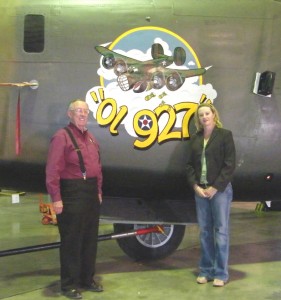
B-24 and B-29 squadron leader Lyn Fite (left) and CAF executive Wendy Stoneman pose next to Ol 927 nose art on the B-24 Liberator.
As the B-29 doesn’t have nose gear steering, the pilot uses differential steering. Taxi turns are made using power from the engines with minimum braking. Once in flight, if the pilot finds all in order, he will call, “Engineer’s throttles.” The pilot is then flying the plane and the engineer monitors the engines using his own set of controls to obtain proper power and fuel burn.
The engineer’s panel is full of gauges telling everything about the performance of the four engines. Included in these monitors are chip detectors. Large magnets located in the front and rear of each engine casing pull unusual metal floating in the oil aside and activate the chip detectors.
“Sometimes a chip light will come on, which tells you that you’ve got something going on that is ‘slinging metal’ inside the engine,” explained Fite.
The flight engineer’s job is considered the most important role in the airplane, especially during combat.
“Some runs were 12-hour missions over the Pacific Ocean. If the engineer wasn’t good at managing fuel economy, the whole crew was going to end up in the drink,” said Fite.
One of the big fears for the crews on the B-29 was a water ditching—the cockpit would be 90 feet under water if the plane nosed down.
The power plants
Four Wright R-3350-57 engines—twin-row 18-cylinder air-cooled radial types that deliver 2,200 hp at 2,800 revolutions per minute—power all B-29s, including Fifi. However, the 3350 engines have many problems. The back row cylinders get too hot due to lack of airflow. Other bomber crews, such as the B-25 or B17, tried to gain as much altitude as quickly as possible. The B-29 pilots aimed at obtaining as much airspeed as quickly as they could in order to prevent engine overheating.

Steve Brown (left) and Lyn Fite display T-shirts for sale in the CAF American Airpower Heritage Museum gift shop.
To overhaul one engine today costs $185,000, and there are four engines on the aircraft plus one spare. The CAF is developing a newer 3350 hybrid engine that can deliver 3,000 HP each. However, the engines’ horsepower will be de-rated to make them last longer.
“Also, we will not use the superchargers that came as standard equipment on the ’29. The first overhauled engine will go on the test stand and we’ll put 50 to 60 hours on it to make sure it’s doing what we want it to do,” said Fite.
Fite explained that the B-29 airframe has been thoroughly inspected and made corrosion-free.
In January 2008, the Cavanaugh Air Museum, located in Addison, Texas, contacted the CAF, making a proposition the CAF couldn’t refuse. CAM said that if it could base Fifi along with its B-24 Liberator in Addison, the CAM would donate $1.2 million for the engine overhaul project. The CAF agreed and as soon as the restoration is complete, Fifi will have a new home in Addison.
“Several pilots are qualified to fly our B-29,” Fite said. “They’re either current or retired airline transport pilots who must pass a very strenuous qualification program. Generally, the ATPs will start in the right seat of the B-24, then do time in the right seat of the B-29.”
Ol 927
The CAF also owns a B-24-A Liberator that Fite said is the oldest continuous flying warbird in the world. It flew for many years as a transport aircraft, but last year was configured back to the “A” model, as it was originally designed. Consolidated Aircraft, in San Diego, sold the bomber to France but later diverted it to the British and designated as “LB 30” or Land Bomber 30.
While this plane was being used to train British pilots in Albuquerque, N.M., a landing accident destroyed the landing gear. Consolidated repaired the damage in San Diego, and converted it from a bomber to a transport plane. It became the prototype for the C-87 transport aircraft.
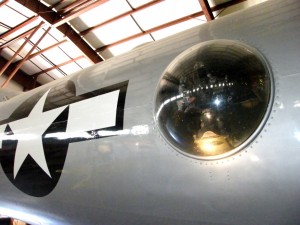
Specially designed Plexiglass windows are installed on the sides of the B-29 Superfortress, allowing excellent visibility for the aircrews on board.
“The only reason we have this aircraft today is because it wasn’t a bomber,” said Fite.
After WWII, Consolidated sold this plane to the Continental Can Company, where it became an executive aircraft. It was considered a luxury liner at that time. CCC sold the plane to PEMEX, Mexico’s state-owned petroleum company. The CAF bought it in 1968 and flew it in the transport configuration for a while. Then the plane was later painted in the scheme of the 98th Bomb Group out of North Africa—better known as “The Pyramiders.” The aircraft was nicknamed Diamond ‘Lil.
Last year, the CAF used abundant historical information, including photos, to complete the conversion back to the B-24 bomber configuration. The only thing not authentically accurate is the logo.
“We had a contest to pick a nickname,” said Fite. “The original serial number was AM927. The archives say that it was referred to as “Ol 927.” That name was suggested and it stuck.”
This aircraft has four Pratt and Whitney 1830 engines, delivering 1,200 hp each. Each engine burns about 50 gallons of fuel per hour. Originally, each engine had a capacity of 65 gallons of oil.
“We run about 35 gallons now just to keep the weight down,” said Fite.
The tire size (56 inches) is the same as for the B-29. The nose gear tire happens to be the same size as the main gear tire on the Lockheed P-38 Lightning. This design was intentional and allowed for interchanging parts between aircraft types.
The B-24, with a 100-foot wingspan, is 110 feet long and has fuel cells that are the wet-wing type and hold 3,000 gallons of avgas. The brakes are hydraulic. Electric motors drive the cowl flaps. In wartime, the B-24 had a 10-man crew and could carry 8,000 pounds of bombs. The range of the aircraft was 3,700 miles with a full load.
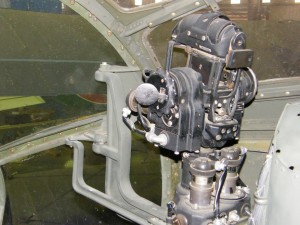
The Norton Bomb Site was top secret in WWII. Crews were instructed to destroy the device rather than have it fall into enemy hands. This particular bomb site was donated to the CAF by Tennessee Ernie Ford, a former squadron leader.
On the CAF tour, Ol 927 leaves in April of each year, and is gone for up to eight months with 15 to 20 stops across the nation. The B-24 can take eight passengers at a time.
Fite, the flight engineer for Ol 927, said that, strangely, the original B-24s only had one hydraulic pump.
“It was located on the number three engine, which is why they always started that engine first—so they could get the hydraulics going. Now, we have hydraulic pumps on engines two and three,” said Fite.
Unlike the B-29, the flight engineer’s position in the B-24 has never been certified.
It doesn’t get any better
Stephan C. Brown, president and CEO, said he’s very enthusiastic about his job.
“I head an organization with more than 9,000 great members, 22 paid staff and a fleet of 160 airplanes,” he said. “It doesn’t get any better than that!”
Brown began his aviation career in 1983 as a commissioned Army officer, and served for five years flying the OH38 and the Bell UH-1 Huey helicopters. After he had worked in consumer marketing for another eight years, the Experimental Aircraft Association hired Brown as chief marketing officer, which he did for five years.
Brown wanted to get active in aviation again, so he applied with an aviation search firm. This brought him to Midland and the CAF.
“My job as president is to make sure the organization is legal and fiducially responsible,” he said.
This past spring, Brown visited squadron units in Texas, Arizona, Georgia, Illinois, California, Ohio and Virginia.
“The best part of my travels has been witnessing the pride that all of the members have in their aircraft and their facilities,” said Brown.
He explained that some aircraft are donated to the CAF, and sometimes, monetary donations are given that are used to purchase aircraft. He said the CAF is beginning an advertising campaign for the first time in its history. Being an expert in marketing, Brown has come up with the slogan, “Join the air force you’ve never heard of.”
“In the world of general aviation, we’re largely unknown,” said Brown. “We just returned from Sun ‘n Fun in Florida where we put up a huge tent. Folks came up to us asking what the CAF is. In Texas, we’re well known in the GA community, but outside this state we’re basically unknown.”
Brown is enthusiastic about promoting the fact that his fleet of aircraft actually fly.
“If it’s important to a person to keep this type of history alive and flying, as opposed to being stuffed in a static museum, they should join the air force they’ve never heard of. If you want to get your hands on history, join the CAF and local units,” said Brown.
He told the story of Keith Woods, who joined the CAF in the early 1990s and worked his way up from flying tail-wheel airplanes to flying a North American P-51. Woods is the wing leader for the Dixie unit in Peachtree City, Ga.
So, how can an individual become a pilot of a P-51 Mustang?
“If you want to get involved, you can do anything you want,” says Brown. “It just comes down to your level of commitment. Woods joined the Dixie unit and started flying the PT-26 (Fairchild Cornell). Then he graduated to the T-6 (North American Texan). After you’ve logged the necessary hours in the T-6, you can qualify to sign off on a fighter check ride. You have to become a sponsor of an aircraft, but it’s not all that much. I think the one-time fee for the P-51 is $10,000. But we’re talking about a million-and-a-half dollar airplane. For an L Bird (Piper L-4 Grasshopper) the sponsorship is only about $1,500.”
Fite added that one can also get a type rating for the B-24 and the B-29.
AIRSHO 2008 and the American Airpower Heritage Museum
The game plan is to have Fifi airworthy for the FINA-CAF AIRSHO, Sept. 20-21, at CAF international headquarters, where more than 100 aircraft will be on display and in the air.
The Commemorative Air Force Headquarters at Midland International Airport is also home to the nationally accredited American Airpower Heritage Museum, which will be open, free of charge, in conjunction with AIRSHO 2008. It houses 40,000 square feet of “hands-on” permanent exhibits that detail the story of WWII airpower.
The Aviation Nose Art Gallery at the museum features 33 pieces of nose art panels, cut from the fuselages of WWI aircraft as they were being scrapped after the war. Giant murals, original video productions and educational activity stations are also included in this one-of-a-kind collection.
A gift shop specializes in aviation-related merchandise.
Privately funded and totally self-supporting, the nonprofit, tax-exempt CAF is an all-volunteer organization made up of members from all walks of life. Membership is open to all men and women, age 18 or older. You need not be a veteran or a pilot to join.
For more information about the CAF, visit [http://www.commemorativeairforce.org]. Visit [http://www.airsho.org] for information about the upcoming Midland presentation. Lyn Fite can be reached at lyn@fitefire.com, and for more information about the Cavanaugh Flight Museum, call 972-380-8800.













